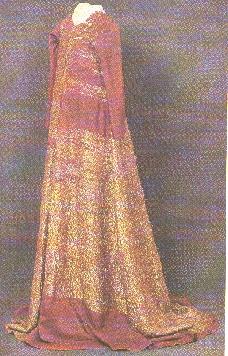
|
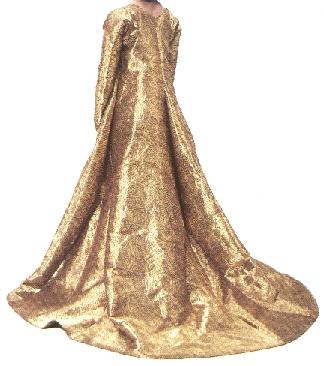
|
The Golden Gown of Margrete
The gown was originally kept in Roskilde Cathedral, at the tomb of Queen Margrete who died in 1412. When Denmark was invaded by Sweden in 1658/59, the relics associated with her were removed and taken to Uppsala Cathedral, where they are today. The size of the gown suggests that the wearer was a young girl, and it is dated to the early 15th Century. While the gown is very closely associated with Margrethe herself, it may in fact have belonged to her daughter-in-law, Philippa of England.
The fabric is a gold brocade on a red silk ground fabric. The design is a framework of laurel garlands with a group of five pomegranates at their points, surrounding a central motif of something that resembles a pineapple. It is generally considered to be of Italian manufacture. The gown will have used around 10 3/4 metres of fabric at the known loom width of 60cm. The careful joining of pieces to make up the main part of the garment was done matching directions in the weave, which will have wasted some of the very expensive fabric. However, some of the inserted gores under the sleeves are of a different fabric, and one of the four main pieces was made up less carefully.
The garment has deep armholes like a grande-assiette garment: although the sleeves survive only as fragments at the top, they do have the expected insets to make the sleeve-cap wide enough to fit. The way the garment widens below the waist is also interesting. As can be seen from the pattern drawings below, there is a noticeable 'hump' over the small of the back, which in a fabric this stiff creates a fold that in modern esthetics would be considered fairly unattractive (see the reconstruction photo below). Since the owner of this garment most definitely could afford a decent tailor, one must assume that this is a feature, not a bug. (My theory on the reasons for this further down!)
The front skirt had apparently been trodden on, and torn. The damage had been repaired with considerable skill, two patches were inserted which made the mending virtually impossible to see. This was done using the same fabric, which suggests that the gown was perhaps made locally to the wearer.

|

|
The cut and construction of the gown was done with great skill and professionalism. The four main pieces are all pieced together to gain the width in the skirt, joined virtually invisibly. Only after the four pieces were completed were they sewn together.
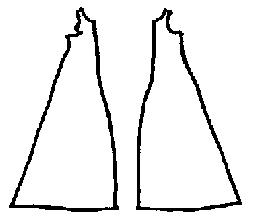
|

|
The Margrete gown is lined with three different types of fabric, a coarse natural linen and two slightly different blue linens. It appears to have originally been interlined with a blue linen through the bodice and at least as far down as where the skirt widens. On top of that, the coarser natural coloured linen was used as a reinforcement in the bodice, and then finally another blue facing was added at the neckline. It seems a prosaic lining for such a spectacular garment, and Nockert speculates that a finer lining still was once attached, possibly a fine fur such as miniver, which has been removed and reused.
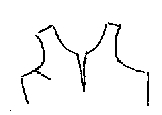
The seam most commonly used is the one seen below to the left. The seam was sewn with a backstitch using double, two-ply S-spun silk, now brown, perhaps originally red. The seam allowance was then flatfelled with a running stitch, except in the waist where they were hemmed down. The side seams in the waist, and the back seam for the top 60-70 cms was reinforced (see below at right). The seams were sewn with a backstitch, then the seam was "taken in" and another row of backstitch sewn through all four layers of fabric, forming a welt. The edges were then flatfelled. These seams were executed with a double linen thread in the back seam. This may have been to take in the seam in the back, but it also serves to 'pad' the gown slightly in the back. The remaining seam allowance in the reinforced seams is approximately 2 cm wide, whereas the ordinary seams have been clipped closely to 0.7-1 cm width.The hemming was very simple, with a 1 cm single fold which was hemmed down with silk.
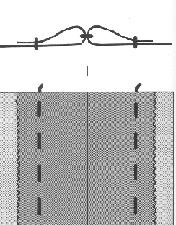
|
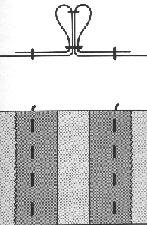
|
Bibliography: Drottning Margaretas gyllene kjortel i Uppsala Domkyrka (The Golden Gown of Queen Margareta in Uppsala Cathedral), Agnes Geijer, Anne Marie Franzen, Margareta Nockert, Kungliga Vitterhets Historie och Antikvitets Akademien, Stockholm 1994
The gown has been altered, we know this because of the linings in the bodice that survive. It has grand assiette sleeves, but they're not really. The sleeve holes are large, but not the incredibly large ones normally seen - rather they're just _big_, and the sleeves then have multiple insets in them, different numbers in the two sleeves.
The four body seams do a funky rounded thing somewhere in the hip region, rather than smoothly tapering out from the bodice and into the skirt, which is enormous - even for the fashion of the time it's both long and wide in comparison to the bodice which is rather petite. So it seems reasonable to assume that the gown was taken in for a smaller person, and that's precisely what the Nockert, Geijer and Franzen suggest in the book about the gown.
But what did the original look like?
I think the sleeves were normal sleeves for the time, probably with the sleeve seam just behind the shoulder and a single gusset inserted there. I think the skirt was in proportion to the larger bodice, and I think the seams were tapering in a more 'normal' look. When the gown was taken in, it was taken in through all four seams, leaving a rather large, gaping arm hole in the gown. To fit the now smaller sleeve into this large armhole the 'grande assiette' method of multiple gussets was used, but there was no real intention of making it a grande assiette gown, or the armhole would have been carved out even more.
I also think that once the bodice had been taken in, the tailor made the seam jump out to the original seams, so as to use as much of the fabric as possible rather than scaling the whole thing down. This, I think, is also why the skirt is so much bigger than seems right for that size bodice.
So, in short, when recreating the Margrethe gown, I will attempt to do so for the original look, less skirt in proportion, and normal sleeves.
(note: I'm talking about 'bodice' and 'skirt' only in the sense of those areas on the gown, there is no waist seam in the garment.)